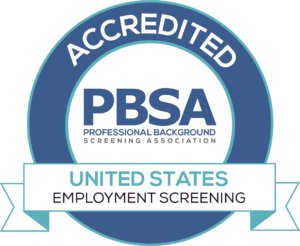Each organization has a unique “why” when it comes to its vetting practices.
Some organizations are simply required to screen employees and are allotted a generous budget to do so.
Others have experienced one or more incidents of workplace violence or fraud.
Some may see a drastic decrease in employee turnover when following a clearly-defined background and drug screening program.
Ultimately, every organization has different needs and will experience different challenges. That being said, there are certain needs and challenges that are shared among many.
Let’s consider some of the most common.
Quick note: The data presented in this article was obtained through a Peopletrail study, recruiting the input of over 2,500 human resource professionals. You can find more information about this study here.
Ranking the Biggest Screening Pain Points
1. Meeting Regulatory Demands
According to our data, 22 percent of HR professionals cited meeting regulatory demands as their biggest screening challenge.
While some organizations have a bit more oversight than others such as those in the transportation industry or the public sector, regulatory demands also include the state and federal laws that govern everyone.
Every employer has a duty to comply with a number of state and federal employment screening laws. These laws influence a number of things such as:
- The basis of a hiring decision
- The due notification of an adverse decision (pre-adverse and adverse action notices)
- What can and can’t be asked on a job application
- What constitutes proper candidate authorization
- How employee drug screening programs must be communicated and carried out
- How to handle juvenile records
When all is said and done, employers assume a fair amount of background screening compliance liability.
The solution?
Well, a good place to start is with a screening partner that provides compliant data.
Compliant data is information that can be legally used in a hiring decision. The truth is, many screening providers don’t adequately ensure the quality of information before reporting it, opening the employer up to risk.
It is also important to seek a vendor that offers pre-adverse action notice management as well as compliance assistance. This can help ensure rigid compliance with all relevant screening laws and regulations.
A screening partner with a dedication to compliance can remove most of the burden from the shoulders of employers.
2. Receiving Accurate Information
Information accuracy was the top challenge among 17 percent of the HR professionals we surveyed.
Background screening data comes from a number of sources– databases, repositories, county courthouses, federal courthouses, references, etc. If a screening vendor is not deliberate (or knowledgeable) in their efforts, there is a lot of room for information to fall through the cracks or for inaccurate information to find its way into a report.
The solution?
Proper quality assurance protocols.
Quality assurance means accuracy checks on every single file. It means cross-referencing and proper verification of data when accuracy is in question. It means training researchers to identify inconsistencies.
Proper quality assurance is as infrastructural as it is day-to-day, which means it can’t be faked or improvised. Information accuracy begins with industry expertise, high data integrity standards, and effective employee training procedures.
3. Reducing Time-to-Hire
17 Percent of HR professionals cited time-to-hire as their biggest screening concern.
Many organizations, particularly those in the staffing industry, need to fill positions quickly and efficiently. A single day of delay could be the difference between finalizing an offer and resuming the search.
The solution?
Communication is key.
If lines of communication are not well-established between an organization and its screening provider, it is likely that delays will abound. While its influence may seem a bit indirect, timely and helpful support can significantly reduce confusion and chaos that contribute to extended completion timelines. Moreover, poor client-side communication can often be a reflection of a screening vendor’s back-end communication habits with courts, data furnishers, references, and more.
Bottom line? Consider a vendor with established support-based SLAs and an emphasis on enhanced customer service.
4. Improving Screening Process Efficiency
12 Percent of HR professionals cited screening process efficiency as their biggest screening concern.
The screening process requires a number of touchpoints between three or more parties, namely, the hiring organization, the candidate, the screening vendor, and at times, other individuals such as an MRO or a reference. A report must be ordered, consent and authorization must be obtained, results must be adequately reported, and adverse action notices (If applicable) must be delivered. There is a lot going on with each and every background check and many hiring organizations find that processes are less than efficient.
The solution?
Technology plays a big role.
Process automation can introduce incredible efficiency into the screening process. Here are some processes that benefit the most:
- Batch ordering
- Candidate authorization
- Decision-reporting
- Report management
- Document management
Pair these capabilities with a powerful ATS integration, and your screening processes are already quite buttoned-up.
When conducting your vendor search, we would recommend requesting an in-depth demo, giving weight to the vendors with technologies you most identify with.
Takeaways
As we have said many times before, cookie-cutter screening solutions are not often effective– especially for larger organizations with varied positions and multiple locations. Any effort to address unique screening challenges must be deliberate.
Furthermore, alleviating these (and all) employment screening pains requires much more than reliable data alone. It requires expertise at every touchpoint– during discovery, implementation, fulfillment, and ongoing support.
An effective screening partner begins addressing common challenges every time a new research analyst starts their training, every time quality assurance protocols are followed correctly, and every time a phone call is answered promptly. Other things that have a significant bearing include a screening company’s organizational structure (particularly operations and support), process efficiency across all departments, technology (as well as a comprehensive understanding of it), and dedication to compliance.
We hope you found this information helpful! For more information about our solutions and processes, feel free to contact us.










